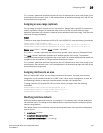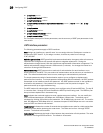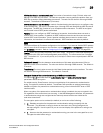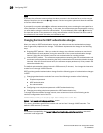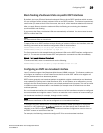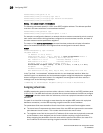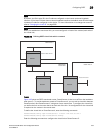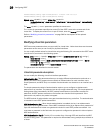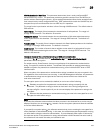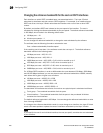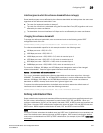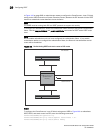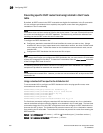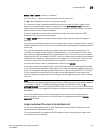
944 PowerConnect B-Series FCX Configuration Guide
53-1002266-01
Configuring OSPF
29
PowerConnectC(config-ospf-router)#area 1 virtual-link 10.0.0.1
PowerConnectC(config-ospf-router)#write memory
Syntax: area <ip-addr> | <num> virtual-link <router-id>
[authentication-key | dead-interval | hello-interval | retransmit-interval | transmit-delay
<value>]
The area <ip-addr> | <num> parameter specifies the transit area.
The <router-id> parameter specifies the router ID of the OSPF router at the remote end of the
virtual link. To display the router ID on a Layer 3 Switch, enter the show ip command.
Refer to “Modifying virtual link parameters” on page 944 for descriptions of the optional
parameters.
Modifying virtual link parameters
OSPF has some parameters that you can modify for virtual links. Notice that these are the same
parameters as the ones you can modify for physical interfaces.
You can modify default values for virtual links using the following CLI command at the OSPF router
level of the CLI, as shown in the following syntax.
Syntax: area <num> | <ip-addr> virtual-link <ip-addr> [authentication-key [0 | 1] <string>]
[dead-interval <num>]
[hello-interval <num>] [md5-authentication key-activation-wait-time <num> | key-id
<num> [0 | 1] key <string>]
[retransmit-interval <num>] [transmit-delay <num>]
The parameters are described in the next section.
Virtual link parameter descriptions
You can modify the following virtual link interface parameters.
Authentication Key: This parameter allows you to assign different authentication methods on a
port-by-port basis. OSPF supports three methods of authentication for each interface—none,
simple password, and MD5. Only one method of authentication can be active on an interface at a
time.
The simple password method of authentication requires you to configure an alphanumeric
password on an interface. The password can be up to eight characters long. The simple password
setting takes effect immediately. All OSPF packets transmitted on the interface contain this
password. All OSPF packets received on the interface are checked for this password. If the
password is not present, the packet is dropped.
The MD5 method of authentication encrypts the authentication key you define. The authentication
is included in each OSPF packet transmitted.
MD5 Authentication Key: When simple authentication is enabled, the key is an alphanumeric
password of up to eight characters. When MD5 is enabled, the key is an alphanumeric password of
up to 16 characters that is later encrypted and included in each OSPF packet transmitted. You
must enter a password in this field when the system is configured to operate with either simple or
MD5 authentication.
MD5 Authentication Key ID: The Key ID is a number from 1 through 255 and identifies the MD5
key that is being used. This parameter is required to differentiate among multiple keys defined on
a router.




